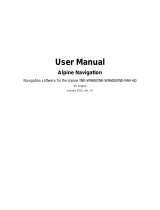3
3.1.5 Selecting a History item .................................................................................................................................................... 39
3.1.6 Selecting a saved route ...................................................................................................................................................... 40
3.1.7 Entering coordinates .......................................................................................................................................................... 41
3.1.8 Selecting a location on the map ..................................................................................................................................... 42
3.1.9 Planning a Multipoint Route ........................................................................................................................................... 42
3.2 Checking Route Information and Alternatives ................................................................................................... 44
3.3 Editing the route ............................................................................................................................................................... 45
3.3.1 Setting a new starting point ............................................................................................................................................ 45
3.3.2 Adding an additional destination .................................................................................................................................. 46
3.3.3 Modifying the list of destinations ................................................................................................................................. 47
3.3.4 Saving the planned route .................................................................................................................................................. 47
3.3.5 Deleting the planned route .............................................................................................................................................. 48
3.3.6 Selecting a route alternative when planning the route ....................................................................................... 48
3.3.7 Selecting a route alternative for an existing route ................................................................................................ 49
3.4 Saving a location ............................................................................................................................................................... 50
3.4.1 Editing a Saved Location ................................................................................................................................................... 51
3.5 Adding an Alert Point ..................................................................................................................................................... 52
3.6 Running a Simulation ..................................................................................................................................................... 53
3.7 Off-road navigation ......................................................................................................................................................... 54
3.7.1 Switching to off-road navigation ................................................................................................................................... 54
3.7.2 Selecting the destination in off-road mode .............................................................................................................. 55
3.7.3 Navigating in off-road mode ........................................................................................................................................... 55
3.7.4 Recording off-road trip logs ............................................................................................................................................ 55
3.7.5 Managing off-road trip logs ............................................................................................................................................. 56
3.8 Updating the navigation software and the maps .............................................................................................. 56
Remove the ALPINE Navi Stick safely from your PC, and plug it back into your Alpine
infotainment system4 Reference guide .................................................................................... 58
4.1 Concepts ................................................................................................................................................................................ 58
4.1.1 2D/3D GPS reception ......................................................................................................................................................... 58
4.1.2 Natural and TTS voices ...................................................................................................................................................... 58
4.1.3 Alert Points ............................................................................................................................................................................. 58
4.1.4 Route calculation and recalculation ............................................................................................................................ 59
4.1.5 Smart Zoom ............................................................................................................................................................................ 59
4.1.6 Speed limit warning ............................................................................................................................................................ 59
4.1.7 Intelligent navigation ......................................................................................................................................................... 60
4.1.7.1 Congestion detour on highways ....................................................................................................................................................... 60
4.1.7.2 Real-time alternative routes .............................................................................................................................................................. 60
4.1.7.3 Parking around destination ............................................................................................................................................................... 61






















